3 Process approach
3.1 Process
Process types, management, realization and support processes
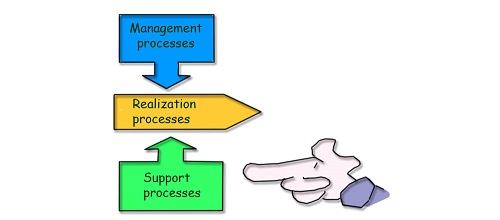
If you cannot describe what you are doing as a process, you do not know what you're doing. Edwards Deming
The word processactivities which transform inputs into outputs (see also ISO 9000, 3.4.1) comes from the Latin root procedere = go, development, progress (Pro = forward, cedere = go). Each processactivities which transform inputs into outputs (see also ISO 9000, 3.4.1) transforms inputs into outputs, creating added value and potential nuisances.
A processactivities which transform inputs into outputs (see also ISO 9000, 3.4.1) has three basic elements: inputs, activities, outputs. .jpg)
A processactivities which transform inputs into outputs (see also ISO 9000, 3.4.1) can be very complex (launch a rocket) or relatively simple (audit a productany outcome of a process or activity (see also ISO 9000, 3.4.2)). A processactivities which transform inputs into outputs (see also ISO 9000, 3.4.1) is:
- repeatable
- foreseeable
- measurable
- definable
- dependent on its context
- responsible for its external providers
A processactivities which transform inputs into outputs (see also ISO 9000, 3.4.1) is determined, among other thingss, by its:
- title and type
- purpose (why?)
- beneficiary (for whom?)
- scope and activities
- initiators
- documented information
- inputs
- outputs (intentional and not intentional)
- restraints
- people
- material resources
- objectives and indicators
- person in charge (owner) and actors (participants)
- means of inspection (monitoring, measurement)
- mapping
- interaction with other processes
- risks and potential deviations
- opportunities for continual improvement
A processactivities which transform inputs into outputs (see also ISO 9000, 3.4.1) review is conducted periodically by the processactivities which transform inputs into outputs (see also ISO 9000, 3.4.1) owner (cf. annex 05). .gif)
Review: a survey of a file, product or process so as to verify if pre-set objectives are achieved
The components of a process are shown in figure 3-1: .jpg)

Figure 3-1. Components of a process
Figure 3-2 shows an example that helps to answer some questions:
- which materials, which documents, which tooling? (inputs)
- which title, what objective, which activities, requirements, constraints? (process)
- which products, which documents? (outputs)
- how, which inspections? (methods)
- what is the level of performance? (indicators)
- who, with what competence? (people)
- with what, which machines, which equipment? (material resources)

Figure 3-2. Some elements of a process
Often the output of a processactivities which transform inputs into outputs (see also ISO 9000, 3.4.1) is the input of the next processactivities which transform inputs into outputs (see also ISO 9000, 3.4.1).
.gif)
Any organizationa structure that satisfies a need (see also ISO 9000, 3.3.1) (company) can be considered as a macro processactivities which transform inputs into outputs (see also ISO 9000, 3.4.1), with its purpose, its inputs (customeranyone who receives a product (see also ISO 9000, 3.3.5) needs and expectations) and its outputs (products/services to meet customeranyone who receives a product (see also ISO 9000, 3.3.5) requirementsexplicit or implicit need or expectation (see also ISO 9000, 3.1.2)).
Our preference is to identify a processactivities which transform inputs into outputs (see also ISO 9000, 3.4.1) using a verb (buy, produce, sell) instead of a noun (purchases, production, sales) to differentiate the processactivities which transform inputs into outputs (see also ISO 9000, 3.4.1) of the company's department or documented information to maintain and recall the purpose of the processactivities which transform inputs into outputs (see also ISO 9000, 3.4.1).
The processes are (as we shall see in the following paragraphs) of management, realization and support type. Do not attach too much importance to processactivities which transform inputs into outputs (see also ISO 9000, 3.4.1) categorizing (sometimes it's very relative) but ensure that all the company's activities fall at least into one processactivities which transform inputs into outputs (see also ISO 9000, 3.4.1).
3.1.1 Management processes
The following processes can be part of this family:
- develop strategy
- establish process ownership
- develop policy
- deploy objectives
- address risks
- plan the QMS
- acquire and manage resources
- communicate
- negotiate contract
- measure customer satisfaction
- meet requirements
- conduct an audit
- conduct management review
- improve
3.1.2 Realization processes
They are mainly:
- guarantee product safety
- maintain equipment
- manage metrology
- carry out FMEA
- carry out process review
- design and develop
- manage special characteristics
- approve product
- purchase components
- control outsourced processes
- meet statutory and regulatory requirements
- produce
- receive, store and deliver
- implement control plan
- implement traceability
- manage changes
- sell products
- approve rework and repair
- dispose of nonconforming products
- inspect production
- control nonconformities
- implement corrective actions
- solve problems
- use error-proofing devices
3.1.3 Support processes
The support processes are often:
- manage staff
- maintain infrastructure
- manage inspection means
- provide training
- provide information
- control documentation
- keep accountability
3.2 Process mapping
Process mapping and house
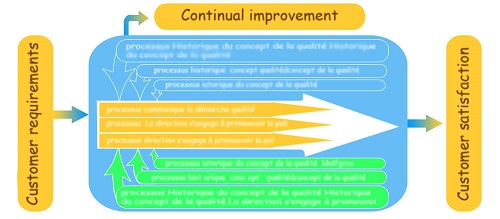
Par excellence processactivities which transform inputs into outputs (see also ISO 9000, 3.4.1) mapping is a multidisciplinary work. This is not a formal requirementexplicit or implicit need or expectation (see also ISO 9000, 3.1.2) of either the ISO 9001 or IATF 16949 standards but is always welcome.
The three types of processes and some interactions are shown in figure 3-3:

Figure 3-3. Process house
In the outputs, do not underestimate unwanted productsany outcome of a process or activity (see also ISO 9000, 3.4.2) such as rubbish, pollution and rejects.
Mapping, among other things, allows you to:
- obtain a global vision of the company
- identify the beneficiaries (customers), flow and interactions
- define rules (simple) for communication between processes
.jpg)
- develop strategy
- develop policy
- address risks
- plan the QMS
- acquire resources
- establish process ownership
- improve
Two other processactivities which transform inputs into outputs (see also ISO 9000, 3.4.1) examples ("design", figure 3-4 and "produce", figure 3-5) are: .jpg)
.jpg)
Figure 3-4. Design process
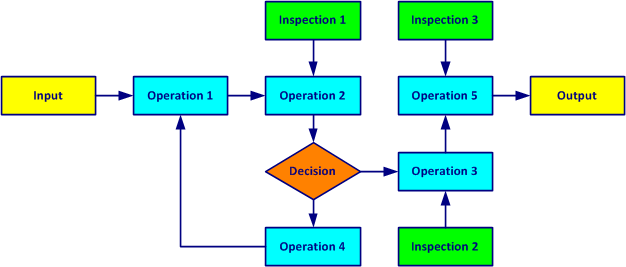
Figure 3-5. Produce process
.jpg) Minute of relaxation. Game: Process
Minute of relaxation. Game: Process
3.3 Process approach
Process approach and continual improvement
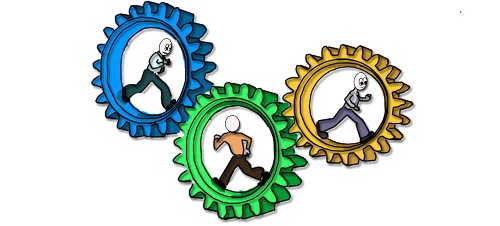
Simple solutions for now, perfection for later
The process approachmanagement by the processes to better satisfy customers, improve the effectiveness of all processes and increase global efficiency (see also ISO 9004, Annexe B.5) contributes enormously to the efficient management of the company (cf. annex 08)..gif)
Process approach: management by the processes to better satisfy customers, improve the effectiveness of all processes and increase global efficiency
When the process approachmanagement by the processes to better satisfy customers, improve the effectiveness of all processes and increase global efficiency (see also ISO 9004, Annexe B.5) is integrated during the development, implementation and continual improvementpermanent process allowing the improvement of the global performance of the organization (see also ISO 9000, 3.2.13 and ISO 14 001, 3.2) of a quality management systemset of processes allowing the achievement of the quality objectives (see also ISO 9000, 3.2.3), it allows one to achieve objectives that are related to customer satisfactiontop priority objective of every quality management system (see also ISO 9000, 3.1.4), as is shown in figure 3-6.
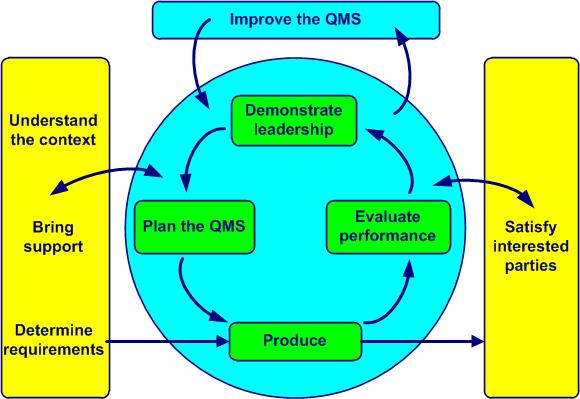
Figure 3-6. Model of a Quality Management System based on process approach and continual improvement
- emphasizes the importance of:
- understanding and complying with customer requirements
- prevention so as to react to unwanted elements such as:
- customer returns
- waste
- measuring process performance, effectiveness and efficiency
- permanently improving objectives based on pertinent measurements
- process added value
- relies on:
- methodical identification
- interactions
- the sequence and
- process management, which consists of:
- determining objectives and their indicators
- piloting related activities
- analyzing obtained results
- permanently undertaking improvement
- allows one to:
- better view inputs and outputs and their relationship
- clarify roles and responsibilities
- judiciously assign necessary resources
- break down the barriers between departments
- decrease costs, delays and waste
- and ensures in the long run:
- control
- monitoring and
- continual improvement of processes
- crisis management ("You will not solve the problems by addressing the effects")
- blaming people ("Poor quality is the result of poor management." Masaaki Imai)
- prioritizing investments ("Use your brain, not your money." Taiichi Ohno)
3.4 PDCA cycle
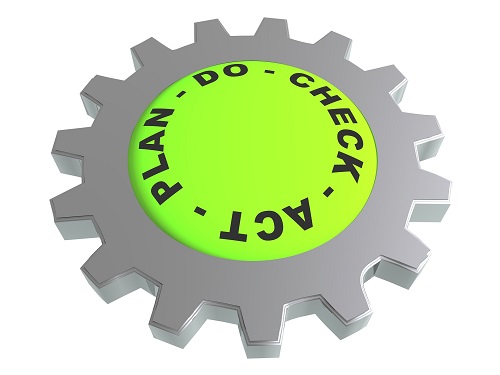
The Deming cycle (figure 3-7) applies to the control of any process. FMEA is a process par excellence. PDCA cycles (Plan, Do, Check, Act) are a universal basis for continual improvement.
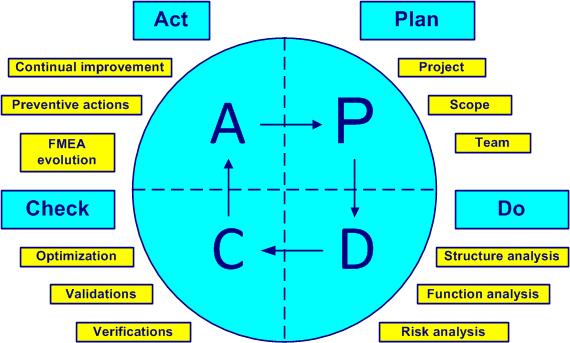
Figure 3-7. The Deming cycle and FMEA
Plan – define the project, define the scope, bring the team together, deadlines not to be exceeded
Do – realize structure analysis, function analysis, failure analysis, cause analysis, risk analysis
Check – verify whether objectives are achieved, validate actions, optimize, implement control plan
Act - adjust, adapt, improve, react with preventive actions, find new improvements (new FMEA or new PDCA)
More information on the Deming cycle and its 14 points of management theory, you can consult the classic work “Out of the Crisis”, W. Edwards Deming, MIT Press, 1982.
 Minute of relaxation. Paganini's violin concert performed with facial expressions.
Minute of relaxation. Paganini's violin concert performed with facial expressions.
